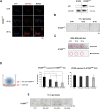TP53 drives abscopal effect by secretion of senescence-associated molecular signals in non-small cell lung cancer
- PMID: 33673859
- PMCID: PMC7934399
- DOI: 10.1186/s13046-021-01883-0
TP53 drives abscopal effect by secretion of senescence-associated molecular signals in non-small cell lung cancer
Abstract
Background: Recent developments in abscopal effect strongly support the use of radiotherapy for the treatment of metastatic disease. However, deeper understanding of the molecular mechanisms underlying the abscopal effect are required to best benefit a larger proportion of patients with metastasis. Several groups including ours, reported the involvement of wild-type (wt) p53 in radiation-induced abscopal effects, however very little is known on the role of wtp53 dependent molecular mechanisms.
Methods: We investigated through in vivo and in vitro approaches how wtp53 orchestrates radiation-induced abscopal effects. Wtp53 bearing (A549) and p53-null (H1299) NSCLC lines were xenotransplanted in nude mice, and cultured in 2D monolayers and 3D tumor spheroids. Extracellular vesicles (EVs) were isolated from medium cell culture by ultracentrifugation protocol followed by Nanoparticle Tracking Analysis. Gene expression was evaluated by RT-Real Time, digital qRT-PCR, and dot blot technique. Protein levels were determined by immunohistochemistry, confocal anlysis, western blot techniques, and immunoassay.
Results: We demonstrated that single high-dose irradiation (20 Gy) induces significant tumor growth inhibition in contralateral non-irradiated (NIR) A549 xenograft tumors but not in NIR p53-null H1299 or p53-silenced A549 (A549sh/p53) xenografts. We further demonstrates that irradiation of A549 cells in vitro induces a senescence-associated secretory phenotype (SASP) producing extracellular vesicles (EVs) expressing CD63 and carrying DNA:RNA hybrids and LINE-1 retrotransposon. IR-A549 EVs also hamper the colony-forming capability of recipient NIR A549 cells, induce senescent phenotype, nuclear expression of DNA:RNA hybrids, and M1 macrophage polarization.
Conclusions: In our models, we demonstrate that high radiation dose in wtp53 tumors induce the onset of SASP and secretion of CD63+ EVs loaded with DNA:RNA hybrids and LINE-1 retrotransposons that convey senescence messages out of the irradiation field triggering abscopal effect in NIR tumors.
Keywords: Abscopal effect; Cellular senescence; DNA:RNA hybrids; Extracellular vesicles; Non-small cell lung cancer; Retrotransposon; TP53.
Conflict of interest statement
There are no potential conflicts of interest to declare.
Figures








Similar articles
-
The CD44high Subpopulation of Multifraction Irradiation-Surviving NSCLC Cells Exhibits Partial EMT-Program Activation and DNA Damage Response Depending on Their p53 Status.Int J Mol Sci. 2021 Feb 27;22(5):2369. doi: 10.3390/ijms22052369. Int J Mol Sci. 2021. PMID: 33673439 Free PMC article.
-
p53 Cooperates berberine-induced growth inhibition and apoptosis of non-small cell human lung cancer cells in vitro and tumor xenograft growth in vivo.Mol Carcinog. 2009 Jan;48(1):24-37. doi: 10.1002/mc.20453. Mol Carcinog. 2009. PMID: 18459128
-
The p53-53BP1-Related Survival of A549 and H1299 Human Lung Cancer Cells after Multifractionated Radiotherapy Demonstrated Different Response to Additional Acute X-ray Exposure.Int J Mol Sci. 2020 May 8;21(9):3342. doi: 10.3390/ijms21093342. Int J Mol Sci. 2020. PMID: 32397297 Free PMC article.
-
Cellular senescence in lung cancer: Molecular mechanisms and therapeutic interventions.Ageing Res Rev. 2024 Jun;97:102315. doi: 10.1016/j.arr.2024.102315. Epub 2024 Apr 26. Ageing Res Rev. 2024. PMID: 38679394 Review.
-
Cellular Senescence in Non-Small Cell Lung Cancer.Front Biosci (Landmark Ed). 2023 Dec 28;28(12):357. doi: 10.31083/j.fbl2812357. Front Biosci (Landmark Ed). 2023. PMID: 38179738 Review.
Cited by
-
Analysis of the Genetic Characteristics and Metastatic Pathways of G1 and G2 Colorectal Neuroendocrine Neoplasms.J Endocr Soc. 2023 Dec 26;8(2):bvad168. doi: 10.1210/jendso/bvad168. eCollection 2024 Jan 5. J Endocr Soc. 2023. PMID: 38205165 Free PMC article.
-
Senescence and the tumor-immune landscape: Implications for cancer immunotherapy.Semin Cancer Biol. 2022 Nov;86(Pt 3):827-845. doi: 10.1016/j.semcancer.2022.02.005. Epub 2022 Feb 7. Semin Cancer Biol. 2022. PMID: 35143990 Free PMC article. Review.
-
Extracellular Vesicle- and Mitochondria-Based Targeting of Non-Small Cell Lung Cancer Response to Radiation: Challenges and Perspectives.Cancers (Basel). 2024 Jun 15;16(12):2235. doi: 10.3390/cancers16122235. Cancers (Basel). 2024. PMID: 38927940 Free PMC article. Review.
-
Network pharmacology and molecular docking reveal the mechanism of action of Bergapten against non‑small cell lung cancer.Oncol Lett. 2024 Dec 4;29(2):87. doi: 10.3892/ol.2024.14833. eCollection 2025 Feb. Oncol Lett. 2024. PMID: 39677411 Free PMC article.
-
Aging microenvironment and antitumor immunity for geriatric oncology: the landscape and future implications.J Hematol Oncol. 2023 Mar 21;16(1):28. doi: 10.1186/s13045-023-01426-4. J Hematol Oncol. 2023. PMID: 36945046 Free PMC article. Review.
References
MeSH terms
Substances
LinkOut - more resources
Full Text Sources
Other Literature Sources
Medical
Research Materials
Miscellaneous

